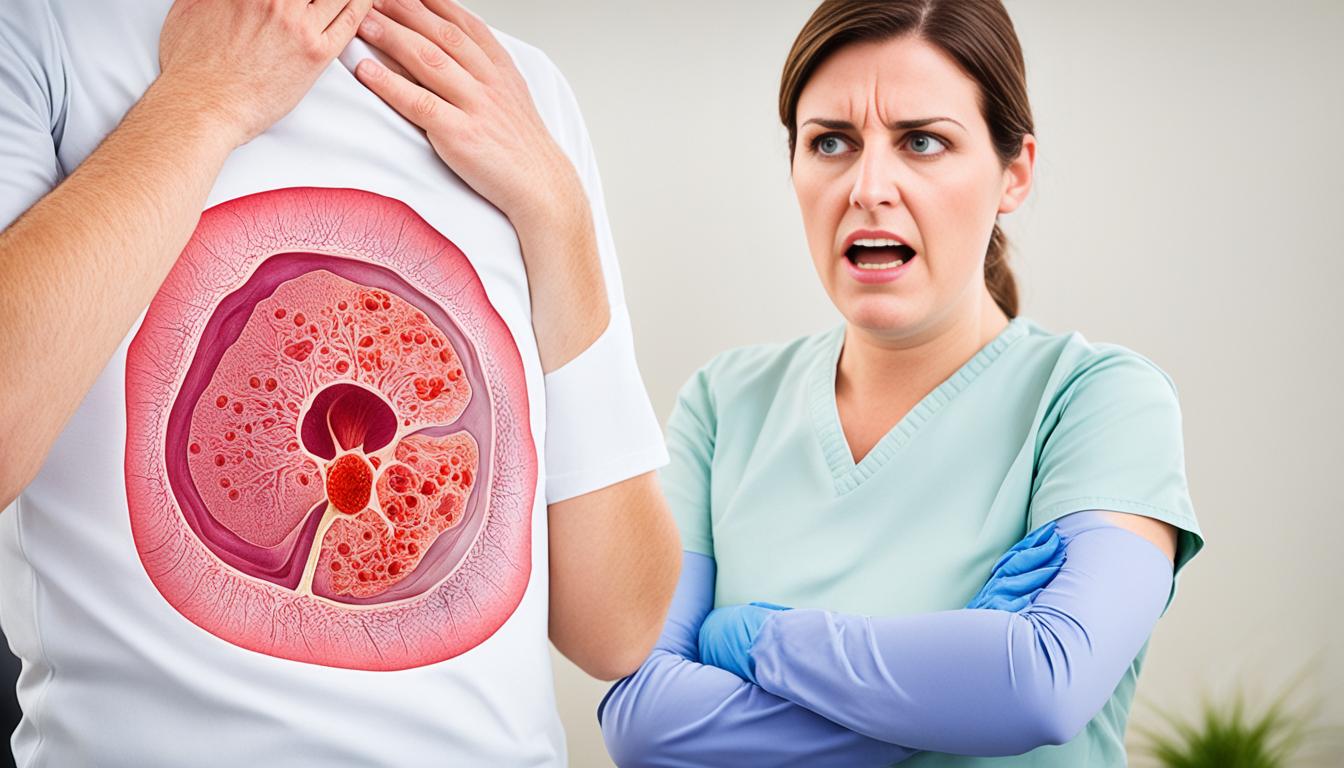Nonulcer dyspepsia, or functional dyspepsia, is a common stomach problem. It causes indigestion and stomach pain. Patients feel pain in their upper belly, bloating, and sometimes nausea. This issue sticks around and can make daily life hard.
The true cause of this sickness is a bit of a mystery. Experts think it’s linked to irritable bowel syndrome and a germ called Helicobacter pylori. These things mess up how the gut works, causing the symptoms.
Doctors diagnose nonulcer dyspepsia by first checking for other gut issues. They use tests like upper endoscopy to look inside your stomach, as well as ultrasound. These tests check for other problems and help rule them out.
Treating this condition aims to make life easier. This includes changing your eating habits and finding ways to relax. Some people might need medicine like antacids. It’s also important to tackle stress and worry because they can make the pain worse.
There’s also a new treatment in the works called stem cell therapy. It aims to fix the stomach by using special cells that can grow into different tissues. This treatment is not ready yet but offers hope for the future of helping those with nonulcer dyspepsia.
Key Takeaways:
- Nonulcer dyspepsia is a common stomach issue that brings indigestion and pain.
- Main symptoms include upper belly pain, feeling full, indigestion, and sometimes nausea.
- To diagnose, doctors usually check for other digestive problems first.
- Treatment can involve lifestyle changes, drugs, and addressing stress.
- Stem cell therapy may become a new way to treat this condition in the future.
Symptoms and Diagnosis of Nonulcer Dyspepsia
Nonulcer dyspepsia is also called functional dyspepsia. It shows symptoms similar to many stomach issues. People with it often feel stomach pain, bloating, or indigestion. Sometimes, it’s hard to tell it apart from diseases like peptic ulcers or gallstones.
To find out if it’s nonulcer dyspepsia, doctors first rule out other problems. They do tests like upper endoscopy and an ultrasound. With upper endoscopy, they look at your digestive system with a tiny camera. An ultrasound can show clear pictures of your stomach, helping find issues like gallstones.
There’s no specific test just for nonulcer dyspepsia. Diagnosis comes by excluding other stomach problems. This can be tricky. It requires a careful check to make sure nothing else is causing the symptoms.
Common symptoms of nonulcer dyspepsia:
- Abdominal pain
- Bloating
- Indigestion
- Nausea
Doctors, by reviewing symptoms and doing tests, can figure out if it’s nonulcer dyspepsia. Then, they can plan how to help you based on what you need.
Image related to nonulcer dyspepsia symptoms:
Table: Comparison of Symptoms between Nonulcer Dyspepsia and Other Gastrointestinal Disorders
| Nonulcer Dyspepsia | Peptic Ulcer Disease | Gallstones | Stomach Cancer |
|---|---|---|---|
| Abdominal pain | Abdominal pain | Abdominal pain | Abdominal pain |
| Bloating | Bloating | Upper right abdominal pain | Early satiety |
| Indigestion | Indigestion | Nausea and vomiting | Weight loss |
| Nausea | Heartburn | Burping | Black, tarry stools |
Treatment and Management of Nonulcer Dyspepsia
Patients with nonulcer dyspepsia often feel better after reassurance and lifestyle changes. Addressing anxiety and stress is crucial since they impact the symptoms. Therapy and techniques to reduce stress can make a big difference in how they feel.
Eating the right foods is very important for those with nonulcer dyspepsia. They should stay away from spicy or fatty foods that make their symptoms worse. A diet full of fruits, vegetables, and whole grains is recommended. This diet supports good digestive health, reducing stomach problems.
Both smoking and drinking alcohol can make dyspepsia symptoms more severe. Patients are advised to quit smoking and reduce the amount of alcohol they consume. Doing so can help the health of their stomach and intestines.
Medications play a role in easing nonulcer dyspepsia for some people. Antacids can help with heartburn by neutralizing stomach acid. Proton pump inhibitors lower the stomach’s acid levels. Prokinetics speed up the digestive process. This helps with bloating and feeling full.
But, keep in mind that not all medications work the same for everyone. Sometimes, using a mix of medicines may be necessary. Finding the right combination is part of managing this condition.
Treating nonulcer dyspepsia often involves working closely with a healthcare provider. While treatments can control and reduce symptoms, the condition might not fully go away quickly. Being patient and sticking to the management plan is essential. This approach can improve life quality for those with nonulcer dyspepsia.
Conclusion
Nonulcer dyspepsia, also called functional dyspepsia, is a common tummy issue. It shows up as indigestion, stomach issues, and pain in the top belly. This problem is linked to eating meals or snacks and feeling full, along with pain in the upper belly. The exact reason behind it is not clear, but it might be connected to how the stomach moves food and ongoing indigestion.
Finding out if someone has nonulcer dyspepsia can be hard. Doctors have to first rule out other stomach problems. They do this with tests like looking inside your stomach with a scope and using ultrasound. After the diagnosis, the treatment focuses on changing your life habits, managing stress, and using medicine to feel better. But what works for one person might not work for another.
There’s hope on the horizon for those dealing with nonulcer dyspepsia. Stem cell therapy is becoming a promising choice for treatment. This new method aims to help lessen the suffering of people with ongoing symptoms. If you’re dealing with this condition, getting the right medical help is very important. This is the first step towards a clear diagnosis and the right care.

